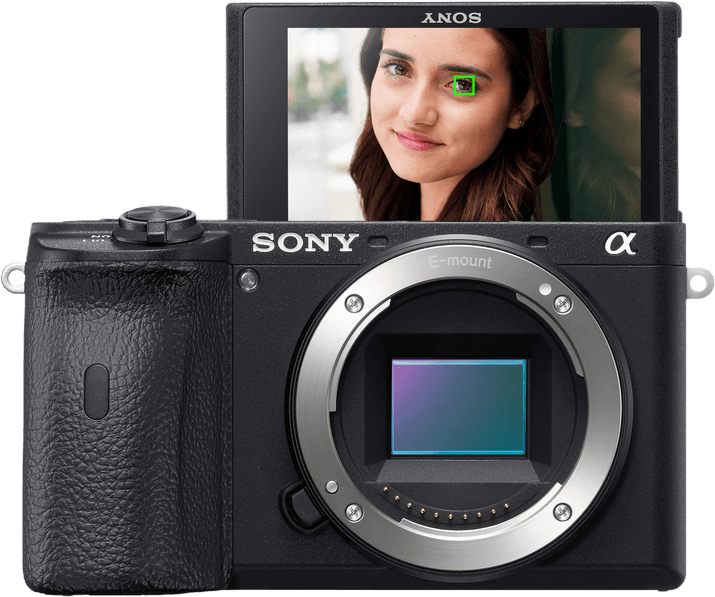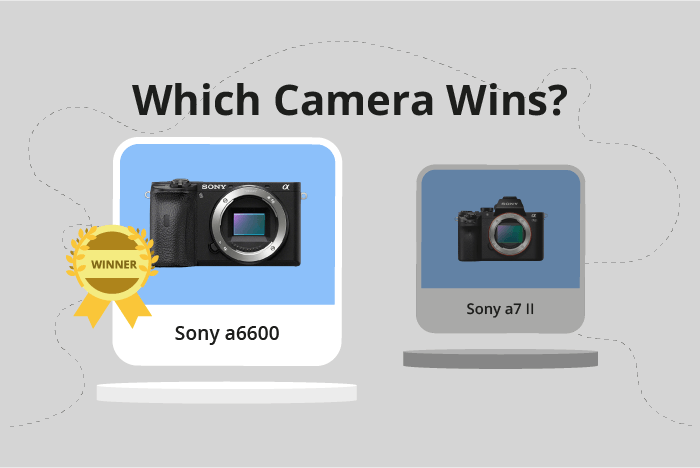Sony a6600 vs a7 II Comparison
Sony a6600

Sony a7 II

The Sony a6600 outperforms the Sony a7 II with a score of 75/100 compared to 69/100. Both cameras are mirrorless and share some common specifications. However, the a6600, announced in 2019, is a more recent model than the a7 II, which was announced in 2014.
The a6600 has an advantage in terms of size and weight, measuring 120 x 67 x 69mm and weighing 503g, making it more portable than the a7 II, which measures 127 x 96 x 60mm and weighs 599g. Additionally, the a6600 has a lower launch price of $1200 compared to the a7 II’s $1600.
On the other hand, the Sony a7 II may have some benefits, despite its lower score. However, the information provided does not indicate any specific advantages over the a6600.
Taking these factors into consideration, the Sony a6600 is a better choice for those seeking a more compact and affordable mirrorless camera while still offering high-quality performance.
Sony a6600 vs a7 II Overview and Optics
The Sony a7 II wins in the optics comparison with a score of 78/100, while the Sony a6600 scores slightly lower at 76/100. Both cameras share similarities in their specifications, such as 24.2 megapixels, CMOS sensor type, Bionz X processor, Sony E lens mount, and image stabilization.
The winning camera, Sony a7 II, has a higher DXOMARK score for its sensor at 90, compared to the a6600’s score of 82. This difference in scores reflects the a7 II’s better image quality due to its full-frame sensor size. The larger sensor size allows the a7 II to capture more light and produce better low-light performance, dynamic range, and image detail. Consequently, the Sony a7 II is more suitable for professional photography and demanding situations where image quality is essential.
On the other hand, the Sony a6600 has some advantages, despite its lower optics score. The a6600 has a faster shooting speed of 11 frames per second, compared to the a7 II’s 5 frames per second. This faster shooting speed makes the a6600 better for capturing fast-moving subjects, such as sports and wildlife photography. Additionally, the a6600’s smaller APS-C sensor size contributes to its lighter and more compact body, making it more convenient for travel and casual use.
To sum up, the Sony a7 II is the better choice for photographers who prioritize image quality and performance in challenging conditions. However, the Sony a6600 offers advantages in shooting speed and portability, making it a suitable option for those who require a fast and lightweight camera.
Sony a6600 vs a7 II Video Performance
The Sony a6600 outperforms the Sony a7 II in video capabilities with a significant difference in their scores, 91/100 and 56/100 respectively. Both cameras share some common features, such as the ability to record video and adjust video settings manually. However, there are key differences that make the Sony a6600 superior in this aspect.
Firstly, the Sony a6600 has a maximum video resolution of 4K (3840 x 2160), while the Sony a7 II can only record in Full HD (1920 x 1080). This higher resolution provides more detailed and sharper footage, which is essential for professional videographers and content creators. Additionally, the Sony a6600 can record at a maximum frame rate of 100fps, allowing for smoother slow-motion footage compared to the Sony a7 II’s 60fps.
Another advantage of the Sony a6600 is its built-in time-lapse functionality. This feature enables users to create stunning time-lapse videos without the need for additional software or accessories. On the other hand, the Sony a7 II lacks this feature, which may be a drawback for some users.
The Sony a7 II, however, has its own strengths. For instance, its Full HD video capabilities may be sufficient for casual users who do not require 4K resolution. Moreover, its lower video score does not necessarily mean it is a poor choice for video recording; it simply indicates that the Sony a6600 offers more advanced features and better performance in this area.
In comparing the video capabilities of the Sony a6600 and the Sony a7 II, the Sony a6600 is the clear winner due to its higher resolution, faster frame rate, and built-in time-lapse functionality. While the Sony a7 II may still be suitable for casual users, those seeking professional-grade video performance will find the Sony a6600 to be a superior choice.
Sony a6600 vs a7 II Features and Benefits
The Sony a6600 outperforms the Sony a7 II in terms of features, scoring 81 points compared to the latter’s 57 points. Both cameras share certain specifications, such as a 3-inch screen size, flip screen, no GPS, and WIFI connectivity. However, there are significant differences that make the a6600 a superior choice.
The a6600 has a touchscreen, which the a7 II lacks. This feature makes it easier for users to navigate the camera’s settings and enables them to quickly adjust focus points. Additionally, the a6600 comes with Bluetooth connectivity, which the a7 II does not possess. Bluetooth allows for seamless connection to smartphones and other devices, making it more convenient for sharing photos and controlling the camera remotely.
On the other hand, the Sony a7 II has a higher screen resolution, with 1,230,000 dots compared to the a6600’s 921,600 dots. This results in a sharper display, which can be beneficial when reviewing images or navigating the camera’s menu. However, this advantage is somewhat diminished by the absence of a touchscreen.
Considering these points, the Sony a6600 emerges as the better camera in terms of features. Its touchscreen and Bluetooth connectivity offer a more user-friendly experience and greater convenience in sharing and controlling the camera. While the Sony a7 II has a higher screen resolution, this advantage is not enough to outweigh the benefits offered by the a6600. Therefore, the Sony a6600 is the recommended choice for photographers seeking a camera with superior features.
Sony a6600 vs a7 II Storage and Battery
The Sony a6600 outperforms the Sony a7 II in storage and battery, scoring 48/100 compared to the a7 II’s 35/100. Both cameras have one memory card slot and accept SD/SDHC/SDXC cards, as well as Memory Stick Pro Duo for the a6600 and Memory Stick Duo/Pro Duo/Pro-HG Duo for the a7 II.
The a6600 excels with its battery life, offering 810 shots per charge using the NP-FZ100 battery. On the other hand, the a7 II provides only 350 shots with its NP-FW50 battery. Both cameras support USB charging, making it convenient for on-the-go photographers.
While the a7 II does not surpass the a6600 in storage and battery performance, it is still a reliable camera in its own right. Its compatibility with various Memory Stick formats may be advantageous for some users. However, the Sony a6600’s significantly longer battery life and USB charging option make it the superior choice for those prioritizing storage and battery capabilities.
Sony a6600 vs a7 II – Our Verdict
Are you still undecided about which camera is right for you? Have a look at these popular comparisons that feature the Sony a6600 or the Sony a7 II:

